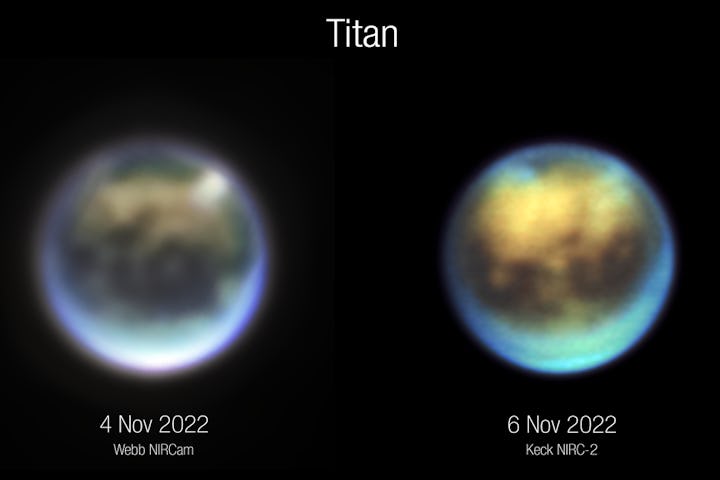These JWST Photos May Not Look Like Much, But They're Actually A Scientific Marvel
The scientists believed a bright spot visible in Titan’s northern hemisphere was a cloud — and they were right.

It’s no secret that the James Webb Space Telescope (JWST) has advanced space science and given us an incredible look at the world beyond ours. However, we still find ourselves surprised when a new image set comes out because each one is more magical than the next. New JWST images just shared are a little different — while they’re not stunning at first glance, the photos are a scientific marvel.
The new photos released by NASA in early December were actually captured on Nov. 4 by the JWST NIRCam instrument showing Saturn’s moon Titan. NASA explains that the moon is the only one in the solar system with a dense atmosphere. The moon is also very similar to Earth — it’s the only other planetary body with seas, lakes, and rivers.
“Unlike Earth, however, the liquid on Titan’s surface is composed of hydrocarbons including methane and ethane, not water,” NASA wrote in a blog post on Dec. 1. With Titan being super unique to the other planetary bodies in our solar system, it’s been a point of great interest. But we’ve not been able to get a good look — until now.
Can you explain what we see in these photos like we’re 5 years old?
For most of us looking at these photos, they don’t seem all that spectacular. Aaccording to researcher Sebastien Rodriguez from the Universite Paris Cité, however, the images are “simply extraordinary.” But why? What are we looking at?
Clouds! The team of scientists believed a bright spot visible in Titan’s northern hemisphere was a cloud, and thanks to the NIRCam, they could confirm what they saw. And then, they spotted a second cloud.
“Detecting clouds is exciting because it validates long-held predictions from computer models about Titan’s climate, that clouds would form readily in the mid-northern hemisphere during its late summertime when the surface is warmed by the Sun,” NASA’s blog reads.
That alone would have been a scientific marvel, but the researchers had another idea: to see if they could capture the clouds moving. “We then realized it was important to find out if the clouds were moving or changing shape, which might reveal information about the air flow in Titan’s atmosphere,” NASA writes.
Webb Titan team lead Conor Nixon from NASA’s Goddard Space Flight Center reached out to Imke de Pater at the University of California, Berkeley, and Katherine de Kleer at Caltech, to see if they could use the Keck Observatory in Hawaii to capture the clouds on Titan and see if they had moved.
In the 30 hours between when JWST captured Titan and Keck Observatory, they could view the location change of the clouds.
“Titan’s trailing hemisphere seen here is rotating from left (dawn) to right (evening) as seen from Earth and the Sun. Cloud A appears to be rotating into view while Cloud B appears to be either dissipating or moving behind Titan’s limb (around toward the hemisphere facing away from us),” the image description reads. “Clouds are not long-lasting on Titan or Earth, so those seen on Nov. 4 may not be the same as those seen on Nov. 6.”
The work hasn’t been peer-reviewed yet, cautions NASA. But the researchers are really excited about the find.
For more details, visit NASA’s blog breaking down this scientific marvel.
This article was originally published on